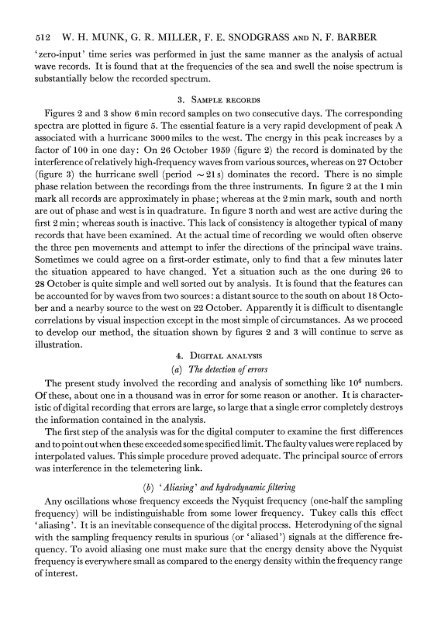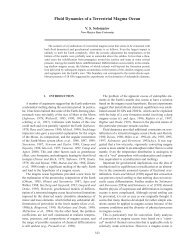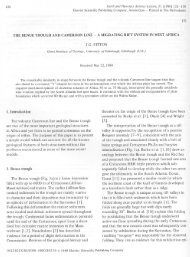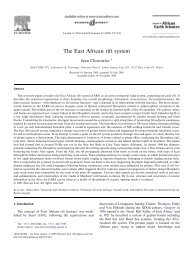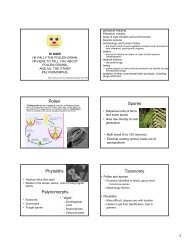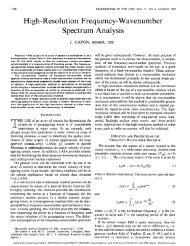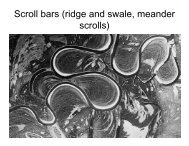Directional Recording of Swell from Distant Storms - Department of ...
Directional Recording of Swell from Distant Storms - Department of ...
Directional Recording of Swell from Distant Storms - Department of ...
You also want an ePaper? Increase the reach of your titles
YUMPU automatically turns print PDFs into web optimized ePapers that Google loves.
512 W. H. MUNK, G. R. MILLER, F. E. SNODGRASS AND N. F. BARBER'zero-input' time series was performed in just the same manner as the analysis <strong>of</strong> actualwave records. It is found that at the frequencies <strong>of</strong> the sea and swell the noise spectrum issubstantially below the recorded spectrum.3. SAMPLE RECORDSFigures 2 and 3 show 6 min record samples on two consecutive days. The correspondingspectra are plotted in figure 5. The essential feature is a very rapid development <strong>of</strong> peak Aassociated with a hurricane 3000 miles to the west. The energy in this peak increases by afactor <strong>of</strong> 100 in one day: On 26 October 1959 (figure 2) the record is dominated by theinterference <strong>of</strong> relatively high-frequency waves <strong>from</strong> various sources, whereas on 27 October(figure 3) the hurricane swell (period -- 21 s) dominates the record. There is no simplephase relation between the recordings <strong>from</strong> the three instruments. In figure 2 at the 1 minmark all records are approximately in phase; whereas at the 2 mmln mark, south and northare out <strong>of</strong> phase and west is in quadrature. In figure 3 north and west are active during thefirst 2 min; whereas south is inactive. This lack <strong>of</strong> consistency is altogether typical <strong>of</strong> manyrecords that have been examined. At the actual time <strong>of</strong> recording we would <strong>of</strong>ten observethe three pen movements and attempt to infer the directions <strong>of</strong> the principal wave trains.Sometimes we could agree on a first-order estimate, only to find that a few minutes laterthe situation appeared to have changed. Yet a situation such as the one during 26 to28 October is quite simple and well sorted out by analysis. It is found that the features canbe accounted for by waves <strong>from</strong> two sources: a distant source to the south on about 18 Octoberand a nearby source to the west on 22 October. Apparently it is difficult to disentanglecorrelations by visual inspection except in the most simple <strong>of</strong> circumstances. As we proceedto develop our method, the situation shown by figures 2 and 3 will continue to serve asillustration.4. DIGITAL ANALYSIS(a) The detection <strong>of</strong> errorsThe present study involved the recording and analysis <strong>of</strong> something like 106 numbers.Of these, about one in a thousand was in error for some reason or another. It is characteristic<strong>of</strong> digital recording that errors are large, so large that a single error completely destroysthe information contained in the analysis.The first step <strong>of</strong> the analysis was for the digital computer to examine the first differencesand to point out when these exceeded some specified limit. The faulty values were replaced byinterpolated values. This simple procedure proved adequate. The principal source <strong>of</strong> errorswas interference in the telemetering link.(b) 'Aliasing' and hydrodynamicfilteringAny oscillations whose frequency exceeds the Nyquist frequency (one-half the samplingfrequency) will be indistinguishable <strong>from</strong> some lower frequency. Tukey calls this effect'aliasing'. It is an inevitable consequence <strong>of</strong> the digital process. Heterodyning <strong>of</strong> the signalwith the sampling frequency results in spurious (or 'aliased') signals at the difference frequency.To avoid aliasing one must make sure that the energy density above the Nyquistfrequency is everywhere small as compared to the energy density within the frequency range<strong>of</strong> interest.


